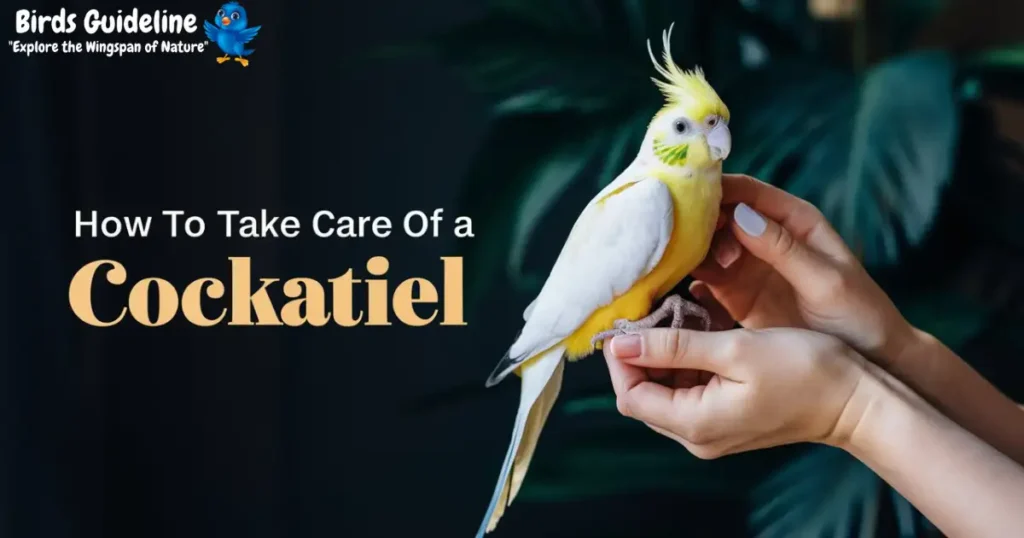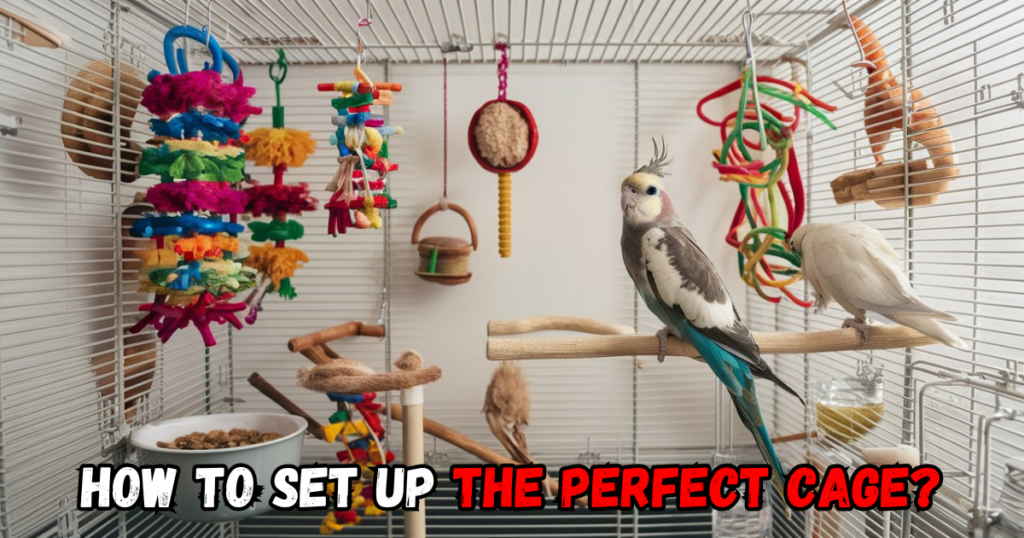Cockatiel wings are often clipped to prevent flight and encourage safety. This process involves trimming the primary feathers. Identify the primary flight feathers and trim only the necessary ones, avoiding any blood feathers. Repeat on the other wing for balance. Clipping your cockatiel’s wings might sound tricky, but learning how to clip your cockatiel’s wings safely can make a big difference in their safety! After researching bird care, I’ve found some simple steps to help you do it right. Join me to discover these safe practices for our delightful feathered pals!
Wing Clipping Process
Wing clipping is a common practice among cockatiel owners. It helps prevent birds from flying away or into danger. It’s a delicate process, and knowing when and how to clip your cockatiel’s wings matters. Doing it right assures your feathered friend stays safe and comfortable.
When To Clip Cockatiel Wings
Choosing the right time to clip your cockatiel’s wings is crucial. Here are key points to consider:
- Age: Wait until your cockatiel is fully feathered, typically around 8-12 weeks old.
- Health: Only clip the wings of a healthy bird. Check with a vet if unsure.
- Molting: Avoid clipping during molting. New feathers need time to grow.
Clipping should also align with your bird’s lifestyle. If your pet spends time outside its cage, consider clipping more often. This table shows a simple schedule:
| Living Condition | Clipping Frequency |
|---|---|
| Free-roaming | Every 1-2 months |
| Caged most of the time | Every 4-6 months |
How To Clip Cockatiel Wings
Follow this Step-by-Step Wing Clipping Guide to safely clip your cockatiel’s wings:

- Gather the right tools: sharp scissors or a bird clipper.
- Hold your cockatiel gently but firmly.
- Spread one wing and identify the primary flight feathers.
- Clip only the necessary feathers, avoiding any blood feathers.
- Repeat on the other wing, making sure to maintain balance.
Remember to clip just enough to prevent flight but allow for safe landing. Always clip symmetrically to avoid causing stress or injury.
How To Handle Blood Feathers
Dealing with blood feathers during clipping is delicate. Here’s what to do:
- Identify: Blood feathers have a dark shaft, indicating a blood supply.
- Avoid: Never clip a blood feather. This could cause bleeding.
- Treat: If a blood feather breaks, apply pressure and seek vet care.
It’s essential to handle your bird with care and monitor for any signs of distress. If you’re ever uncertain, consult a professional for help.
Caring For A Clipped Cockatiel
Clipping a cockatiel’s wings can keep them safe at home. It stops them from flying into dangers. But, after clipping, they need special care. This care helps them stay happy and healthy. Let’s learn how to care for a clipped cockatiel properly.
Indoor Environment
Creating a safe indoor space is key for a clipped cockatiel. Since they can’t fly well, they might fall. Here’s how to make a safe space:

- Use soft mats or carpets on the floor. This helps if they fall.
- Keep windows and doors closed to stop escapes or drafts.
- Remove toxic plants and dangerous items. Cockatiels chew on things. Make sure everything in their reach is safe.
Also, consider their cage:
| Item | Description |
|---|---|
| Cage Size | Big enough for movement, but not too high to prevent falls. |
| Perches | Varying sizes and materials to keep feet healthy. |
| Food and Water | Accessible and clean, placed at a safe height. |
Remember, a safe and comfy home keeps a clipped cockatiel happy.
Exercise And Interaction
Clipped cockatiels still need exercise and love. Here’s how to help:
- Play time outside the cage is a must. Watch them to keep them safe.
- Teach tricks or games. It keeps their mind and body sharp.
- Use toys that encourage movement and problem-solving.
Interaction is also key:
- Talk and sing to your bird. They love hearing your voice.
- Hold and pet them, if they like it. It builds trust and love.
- Introduce them to new people and birds carefully. It helps them be social.
Exercise and love make a clipped cockatiel’s life bright. Always give them your time and attention.
Pros And Cons
Clipping the wings of a cockatiel is a topic that can stir up a lot of emotions among bird owners. It is a decision that comes with both positive and negative aspects. To make an informed choice, It is essential to weigh the pros and cons. This guide will discover the advantages and disadvantages of wing clipping for cockatiels. This helps assure their safety and affects their quality of life. Let’s jump into the specifics of each side.
Advantages Of Wing Clipping
Wing clipping, when done correctly, can provide several benefits for cockatiel owners and their feathered friends. These advantages include:
- Safety: Clipped wings can prevent cockatiels from flying into dangerous areas, such as windows or ceiling fans.
- Easier Training: Birds with clipped wings may be easier to train since they are less able to escape from training sessions.
- Preventing Escape: A cockatiel with clipped wings is less likely to fly away when taken outside.
Beyond these points, a table highlights further advantages:
| Advantage | Description |
|---|---|
| Reduced Aggression | Clipped birds might show less aggression as their ability to fly away is limited, making them more reliant on their owners. |
| Enhanced Bonding | With less chance of flight, cockatiels may bond more closely with their owners, relying on them for movement. |
| Controlled Exploration | Owners can control their pet’s environment more effectively, making sure it discovers safely. |
Disadvantages Of Wing Clipping
While wing clipping has its advantages, it also has several downsides that owners should consider:
- Impaired Mobility: Clipped wings can limit a cockatiel’s ability to move around and exercise.
- Behavioral Changes: Some birds may develop negative behaviors, such as feather plucking or aggression due to the stress of being unable to fly.
- Psychological Impact: Flying is a natural behavior, and preventing it may affect a cockatiel’s mental well-being.
Moreover, a list of additional disadvantages is presented below:
| Disadvantage | Description |
|---|---|
| Reduced Confidence | Without the ability to fly, a cockatiel may become more fearful and less confident in its surroundings. |
| Potential Injury | Incorrectly clipped wings can lead to falls and injuries, as the bird cannot glide to safety. |
| Dependence on Owner | A clipped bird may become overly dependent on its owner for movement, which can be stressful for both. |
Alternatives To Wing Clipping
Many cockatiel owners consider wing clipping to keep their pets safe. Clipping wings can prevent birds from flying away or into danger. Yet, not all owners feel comfortable with this. Good news: there are alternatives! Harness training and flight training offer ways for your cockatiel to enjoy freedom without risks. Let’s discover these kind options for your feathered friend.

Harness Training
Harness training is a safe way to let your cockatiel enjoy the outdoors. Here’s how to start:
- Choose the right harness: Pick a size that fits your bird snugly.
- Introduce slowly: Let your cockatiel see and feel the harness before wearing it.
- Training sessions: Keep them short and positive. Use treats as rewards.
Remember, patience is key. It may take weeks for your cockatiel to get comfortable. Once they do, you both can discover outside safely. Check out this table for a quick guide on harness training:
| Step | Description | Tips |
|---|---|---|
| 1. Introduction | Show the harness to your bird | Use treats and soft words |
| 2. Touching | Let them touch the harness with their beak | Keep it fun, no pressure |
| 3. Wearing | Place the harness on your bird | Short sessions at first |
| 4. Securing | Buckle the harness carefully | Assure it’s not too tight |
| 5. Exploring | Take your bird outside | Stay calm and alert |
Flight Training
Flight training helps your cockatiel fly safely at home. It builds confidence and strengthens their bond with you. Begin with these steps:
- Create a safe space: Remove hazards from the training area.
- Start with short distances: Encourage your bird to fly to you over a small gap.
- Use commands: Teach words like ‘come’ and ‘fly’ to guide them.
As they learn, increase the distance. Always reward with treats and praise. Here’s a simple breakdown of the process:
| Phase | Activity | Goal |
|---|---|---|
| 1. Trust | Build a bond with your bird | Comfort around you |
| 2. Commands | Introduce simple commands | Response to cues |
| 3. Short flights | Encourage flying to you | Controlled, safe flights |
| 4. Longer flights | Increase flying distance | Improved flight skills |
| 5. Advanced tricks | Teach fun aerial maneuvers | Engagement and fun |
With consistent training, your cockatiel will soar with confidence. They’ll stay fit, happy, and close to you.
Frequently Asked Questions
Cockatiels don’t necessarily require wing clipping. It’s a personal choice for owners, balancing safety and flight. Clipping can prevent escape and injury but limits natural flying abilities. Always consult with a vet before proceeding.
Can Birds Recover From Clipped Wings?
Yes, birds can recover from clipped wings. Feathers regrow during their natural molting cycle, allowing flight capability to return. Regular care assures healthy regrowth.
Cockatiel clipped wings typically regrow within 6 to 12 months. This period can vary based on diet, health, and individual growth patterns. Regular check-ups with a vet assure optimal wing health during this regrowth phase.
Conclusion
Clipping a cockatiel’s wings can be a safe way to prevent unwanted escape and injury. It’s essential to approach this with care, respecting your feathered friend’s well-being. Consult a vet, use proper technique, and remember, it’s not a permanent change.
Happy, healthy cockatiels make for joyful companions. Keep their safety and happiness at the forefront, and enjoy the bond you share.



